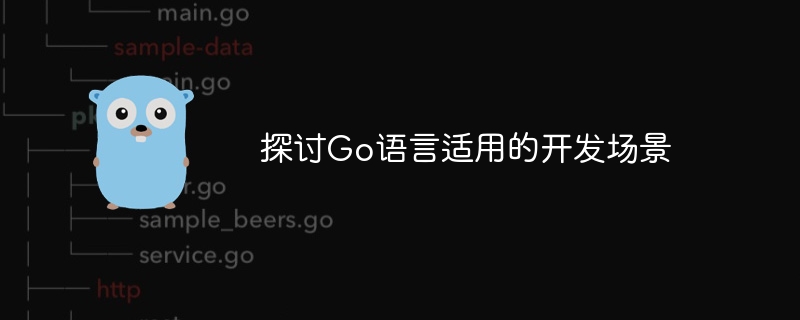Home >Backend Development >Golang >Discuss the development scenarios applicable to Go language
Discuss the development scenarios applicable to Go language
- WBOYWBOYWBOYWBOYWBOYWBOYWBOYWBOYWBOYWBOYWBOYWBOYWBOriginal
- 2024-02-22 17:21:031182browse

Go language, as an open source programming language, is increasingly favored by developers. It has the characteristics of static type, efficient performance, and strong concurrency performance. So, what development scenarios is Go language suitable for? This article will explore the development scenarios applicable to the Go language and illustrate it with specific code examples.
1. Server back-end development
The Go language performs well in server back-end development. It has powerful concurrency performance and can easily handle high concurrency situations. Whether you are building a web server, API service, or backend service, Go language can do it all. The following is a code example of a simple HTTP server:
package main
import (
"fmt"
"net/http"
)
func handler(w http.ResponseWriter, r *http.Request) {
fmt.Fprintf(w, "Hello, World!")
}
func main() {
http.HandleFunc("/", handler)
http.ListenAndServe(":8080", nil)
}Through the above code example, you can see that writing an HTTP server in Go language is very simple and intuitive.
2. Big data processing
Due to the excellent concurrency performance of Go language, it is suitable for processing big data. You can use the coroutines and channels of the Go language to achieve efficient concurrent processing. The following is a simple code example for concurrent processing of data:
package main
import (
"fmt"
"sync"
)
func process(data int, wg *sync.WaitGroup) {
defer wg.Done()
result := data * 2
fmt.Println(result)
}
func main() {
var wg sync.WaitGroup
data := []int{1, 2, 3, 4, 5}
for _, d := range data {
wg.Add(1)
go process(d, &wg)
}
wg.Wait()
fmt.Println("All processing complete.")
}The above code implements concurrent processing of data through coroutines and prints out the result of multiplying each data by 2.
3. Embedded development
Due to the static typing and performance advantages of the Go language, it is also suitable for embedded development. Drivers, control programs, etc. can be written in Go language. The following is a simple code example for controlling LED lights:
package main
import (
"github.com/stianeikeland/go-rpio"
"time"
)
func main() {
err := rpio.Open()
if err != nil {
panic(err)
}
defer rpio.Close()
led := rpio.Pin(17)
led.Output()
for {
led.Toggle()
time.Sleep(time.Second)
}
}The above code uses the third-party library of the Go language to control the LED lights on the Raspberry Pi, achieving a flash of one time per second.
Conclusion
Through the above code examples and discussions, we can see that Go language has excellent performance in server back-end development, big data processing, embedded development and other scenarios. If you need a programming language with high performance and powerful concurrency, Go language is undoubtedly a good choice. To sum up, the Go language has broad application prospects in various development scenarios. I hope this article will be helpful to you.
The above is the detailed content of Discuss the development scenarios applicable to Go language. For more information, please follow other related articles on the PHP Chinese website!
Related articles
See more- 2021 Popular PHP Development Framework Ranking
- Detailed explanation of the characteristics, principles, usage scenarios, and application cases of MongoDB
- How to delete slice elements in go language
- What are the three major application scenarios of 5g?
- How to configure the environment for running go language in idea

